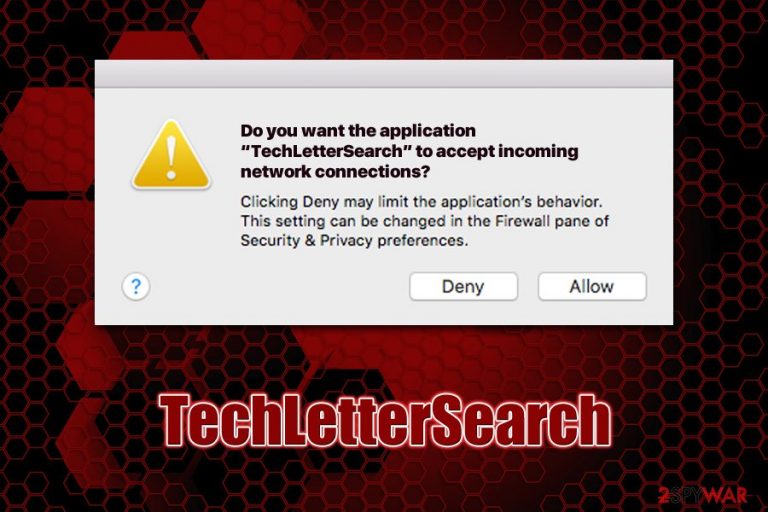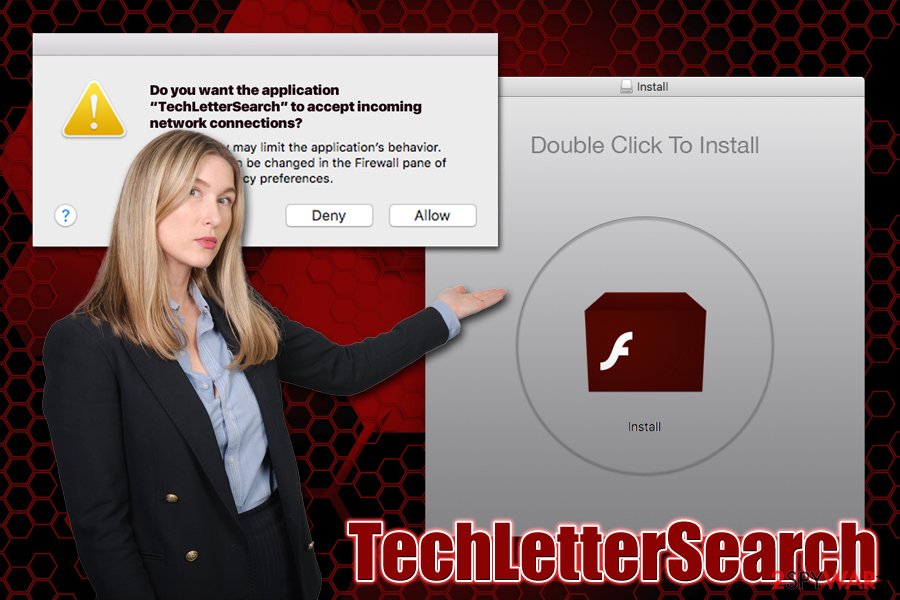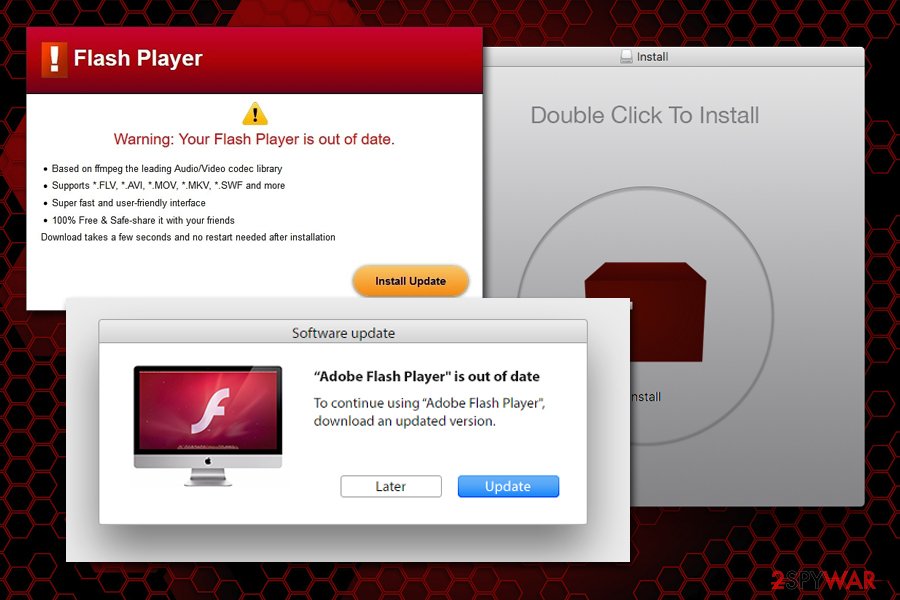TechLetterSearch (Simple Removal Guide) - Free Instructions
TechLetterSearch Removal Guide
What is TechLetterSearch?
TechLetterSearch is a malicious application designed to show macOS users adverts regularly

TechLetterSearch is an adware program that users may find on their Mac computers. In most cases, this borderline malware app is distributed via malicious websites that show fake Flash Player update prompts, or might be found bundled with freeware from third-party websites. As a result, users are rarely aware of the PUA's entry, and only start noticing its existence after they notice Mac prompts and suspicious TechLetterSearch ads.
Once installed, TechLetterSearch virus will start to exhibit unwanted behavior on Safari, Google Chrome, Mozilla Firefox, or another web browser: show pop-ups, flashing windows, in-text links, banners, and other types on ads [sometimes] indicated with TechLetterSearch markings, redirect to suspicious scam or spam sites, etc.
| Name | TechLetterSearch |
| Type | Mac virus, adware |
| Infiltration | In most cases, the PUP is delivered with the help of fake Flash updates or installed along other software from third-party websites |
| Symptoms | Increased amount of advertisements on all visited websites, redirects to unknown domains, TechLetterSearch system notification prompts, changed web browser settings, etc. |
| Associated risks | Leak of anonymous and personal information, installation of potentially unwanted programs and malware, loss of money due to encountered scams, etc. |
| Termination | User anti-malware software that could find all the associated files and entries automatically or check out our manual removal guide below |
| Optimization | If you need a reliable system optimization tool for macOS, download FortectIntego |
Additionally, TechLetterSearch virus will engage in various background behavior that is not immediately visible. For example, the adware will try to establish new network connections with predetermined sites – this is when Mac will warn users with the following notification:
Do you want the application “TechLetterSearch” to accept incoming network connections? Clicking Deny may limit the application's behavior. This setting can be changed in the Firewall pane of Security & Privacy preferences.
Note that this prompt should never be ignored, and you should never allow TechLetterSearch to connect to its network, as it can result in various unforeseen consequences, including additional software installation, which might not be safe. However, users reported that the pop-up warning shows up several times a day, and they do not know to remove these TechLetterSearch prompts, as they disturb normal computer operation.
Another invisible activity that TechLetterSearch will engage in is data tracking. Adware applications are designed to produce various types of ads to users, and they are usually delivered with the help of a virtual layer, redirects, sponsored links, etc. The PUP is capable of doing so by altering the web browser settings, and sometimes establishing its own profile for persistence – the latter can make a regular TechLetterSearch removal and almost impossible task.

The TechLetterSearch data collection practices are performed with the help of tracking technologies such as web beacons,[1] cookies, pixels, JavaScript, and other invisible components. Typically, the collected information includes:
- the IP address;
- Internet Service Provider (ISP);
- technical details of the device and browser;
- browsing data;
- ads interacted with, and other anonymous info.
In some cases, however, the potentially unwanted app like TechLetterSearch might grant itself elevated permissions during the installation, which would allow it to read sensitive data on all websites, such as credit card details.
Therefore, while TechLetterSearch might seem like a nuisance that keeps showing ads on all sites and the cause of occasional system warnings, it can be much more than that. Keep in mind that it is spread with the help of fake update prompts or scam sites, it might be able to read sensitive information on all the sites that you visit, and also may promote bogus software via advertisements.
Therefore, do not hesitate to uninstall TechLetterSearch as soon as you detect its prescience on your macOS. You can either do it anti-malware tools like SpyHunter 5Combo Cleaner or refer to our manual removal guide below. Tip: if you want to get rid of useless files on your Mac and speed it up, we encourage using FortectIntego.
Fake updates and software bundles: main malware attack vectors on macOS
Fake Flash Player updates have been around for years now, and users are still falling for a very old trick. Flash is generally outdated and inefficient software will be terminated by its developer Adobe,[2] as it has too many security flaws that can be abused by cybercriminals and is also often used in scam schemes online. Besides, all modern web browsers have its functionality embedded, so there is no need for an actual plugin to be installed in the first place. However, because the software was so prevalent for many years, users still think it is needed, and some don't even know if they have it installed on their system.
A simple social engineering trick does wonders for cybercriminals, however, as they merely say that they need to update Flash in order to allegedly view website's contents, or that the update is simply due. However, what users are downloading and installing is not a real Flash, but an adware app that can cause a wide array of web browser disturbances, such as redirects, pop-up ads, and similar. In some cases, users also install scareware[3] like Advanced Mac Cleaner, as well as malware (Shlayer Trojan) in the same way.

Therefore, it is best to uninstall Adobe Flash Player altogether, as it is generally useless software for a regular user. If you insist on having it installed, you should always visit the official Adobe site and get it from there. In other words, never believe random notifications, such as update prompts and virus infection warnings that come from within the browser.
Additionally, experts[4] highly advise choosing official software download sources, such as App Store, Amazon, Google Web Store, and so on – these stores have millions of apps combined, so there is plenty to choose from. If, however, you decide to stick to third-parties, watch out of optional components during the installation – pick Advanced/Custom setting, and get rid of all the offers on the way.
You can get rid of pesky ads by eliminating TechLetterSearch from your Mac
Many computer users still believe that Macs cannot fall victim to malware, as Apple implements various built-in security measures that stop much of computer parasites. While it is technically true, there are various ways of malicious software of entering Macs, and TechLetterSearch virus is a perfect example.
Spread with the help of fake updates, it tricks users into letting itself in, and then performs a variety of changes and drops multiple files on the system. For that reason, users may struggle with TechLetterSearch removal. If you want to terminate this potentially unwanted application manually, you should check the following folders on your macOS:
- /Library/LaunchAgents
- /Library/Application Support
- /Library/LaunchDaemons
Additionally, there you should get rid of TechLetterSearch profile (if present):
- Go to Preferences on your Mac
- Select Profiles
- Delete an unrecognized profile by pressing “–” at the bottom left of the window
However, if you do not want to bother with manual elimination, you can easily remove TechLetterSearch automatically with the help of anti-malware software – all you have to do is install it and then perform a full system scan. Note: do not forget to update definitions of security software before proceeding.
You may remove virus damage with a help of FortectIntego. SpyHunter 5Combo Cleaner and Malwarebytes are recommended to detect potentially unwanted programs and viruses with all their files and registry entries that are related to them.
Getting rid of TechLetterSearch. Follow these steps
Delete from macOS
To get rid of adware apps on macOS, move it to Trash as follows:
Remove items from Applications folder:
- From the menu bar, select Go > Applications.
- In the Applications folder, look for all related entries.
- Click on the app and drag it to Trash (or right-click and pick Move to Trash)

To fully remove an unwanted app, you need to access Application Support, LaunchAgents, and LaunchDaemons folders and delete relevant files:
- Select Go > Go to Folder.
- Enter /Library/Application Support and click Go or press Enter.
- In the Application Support folder, look for any dubious entries and then delete them.
- Now enter /Library/LaunchAgents and /Library/LaunchDaemons folders the same way and terminate all the related .plist files.

Remove from Mozilla Firefox (FF)
Remove dangerous extensions:
- Open Mozilla Firefox browser and click on the Menu (three horizontal lines at the top-right of the window).
- Select Add-ons.
- In here, select unwanted plugin and click Remove.

Reset the homepage:
- Click three horizontal lines at the top right corner to open the menu.
- Choose Options.
- Under Home options, enter your preferred site that will open every time you newly open the Mozilla Firefox.
Clear cookies and site data:
- Click Menu and pick Settings.
- Go to Privacy & Security section.
- Scroll down to locate Cookies and Site Data.
- Click on Clear Data…
- Select Cookies and Site Data, as well as Cached Web Content and press Clear.

Reset Mozilla Firefox
If clearing the browser as explained above did not help, reset Mozilla Firefox:
- Open Mozilla Firefox browser and click the Menu.
- Go to Help and then choose Troubleshooting Information.

- Under Give Firefox a tune up section, click on Refresh Firefox…
- Once the pop-up shows up, confirm the action by pressing on Refresh Firefox.

Remove from Google Chrome
Remember to reset Google Chrome after you get rid of TechLetterSearch to ensure its ads do not return:
Delete malicious extensions from Google Chrome:
- Open Google Chrome, click on the Menu (three vertical dots at the top-right corner) and select More tools > Extensions.
- In the newly opened window, you will see all the installed extensions. Uninstall all the suspicious plugins that might be related to the unwanted program by clicking Remove.

Clear cache and web data from Chrome:
- Click on Menu and pick Settings.
- Under Privacy and security, select Clear browsing data.
- Select Browsing history, Cookies and other site data, as well as Cached images and files.
- Click Clear data.

Change your homepage:
- Click menu and choose Settings.
- Look for a suspicious site in the On startup section.
- Click on Open a specific or set of pages and click on three dots to find the Remove option.
Reset Google Chrome:
If the previous methods did not help you, reset Google Chrome to eliminate all the unwanted components:
- Click on Menu and select Settings.
- In the Settings, scroll down and click Advanced.
- Scroll down and locate Reset and clean up section.
- Now click Restore settings to their original defaults.
- Confirm with Reset settings.

Delete from Safari
Remove unwanted extensions from Safari:
- Click Safari > Preferences…
- In the new window, pick Extensions.
- Select the unwanted extension and select Uninstall.

Clear cookies and other website data from Safari:
- Click Safari > Clear History…
- From the drop-down menu under Clear, pick all history.
- Confirm with Clear History.

Reset Safari if the above-mentioned steps did not help you:
- Click Safari > Preferences…
- Go to Advanced tab.
- Tick the Show Develop menu in menu bar.
- From the menu bar, click Develop, and then select Empty Caches.

After uninstalling this potentially unwanted program (PUP) and fixing each of your web browsers, we recommend you to scan your PC system with a reputable anti-spyware. This will help you to get rid of TechLetterSearch registry traces and will also identify related parasites or possible malware infections on your computer. For that you can use our top-rated malware remover: FortectIntego, SpyHunter 5Combo Cleaner or Malwarebytes.
How to prevent from getting mac viruses
Access your website securely from any location
When you work on the domain, site, blog, or different project that requires constant management, content creation, or coding, you may need to connect to the server and content management service more often. The best solution for creating a tighter network could be a dedicated/fixed IP address.
If you make your IP address static and set to your device, you can connect to the CMS from any location and do not create any additional issues for the server or network manager that needs to monitor connections and activities. VPN software providers like Private Internet Access can help you with such settings and offer the option to control the online reputation and manage projects easily from any part of the world.
Recover files after data-affecting malware attacks
While much of the data can be accidentally deleted due to various reasons, malware is one of the main culprits that can cause loss of pictures, documents, videos, and other important files. More serious malware infections lead to significant data loss when your documents, system files, and images get encrypted. In particular, ransomware is is a type of malware that focuses on such functions, so your files become useless without an ability to access them.
Even though there is little to no possibility to recover after file-locking threats, some applications have features for data recovery in the system. In some cases, Data Recovery Pro can also help to recover at least some portion of your data after data-locking virus infection or general cyber infection.
- ^ Vangie Beal. Web beacon. Webopedia. Online Tech Dictionary for Students, Educators and IT Professionals.
- ^ Adobe Flash end of support on December 31, 2020. Microsoft. Microsoft support.
- ^ What is Scareware?. Forcepoint. Security blog.
- ^ Bedynet. Bedynet. Cybersecurity advice and insights.
